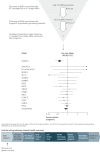Prognosis Research Strategy (PROGRESS) 2: prognostic factor research
- PMID: 23393429
- PMCID: PMC3564757
- DOI: 10.1371/journal.pmed.1001380
Prognosis Research Strategy (PROGRESS) 2: prognostic factor research
Abstract
Prognostic factor research aims to identify factors associated with subsequent clinical outcome in people with a particular disease or health condition. In this article, the second in the PROGRESS series, the authors discuss the role of prognostic factors in current clinical practice, randomised trials, and developing new interventions, and explain why and how prognostic factor research should be improved.
Conflict of interest statement
SS is a full time employee of the BMJ Group but is not involved in the decision making on manuscripts. The authors declare no other competing interests.
Figures



Similar articles
-
Prognosis Research Strategy (PROGRESS) 3: prognostic model research.PLoS Med. 2013;10(2):e1001381. doi: 10.1371/journal.pmed.1001381. Epub 2013 Feb 5. PLoS Med. 2013. PMID: 23393430 Free PMC article. Review.
-
Prognosis research strategy (PROGRESS) 4: stratified medicine research.BMJ. 2013 Feb 5;346:e5793. doi: 10.1136/bmj.e5793. BMJ. 2013. PMID: 23386361 Free PMC article.
-
[Adaptive clinical study methodologies in drug development].Orv Hetil. 2015 Nov 29;156(48):1949-55. doi: 10.1556/650.2015.30295. Orv Hetil. 2015. PMID: 26588853 Review. Hungarian.
-
Prognosis research strategy (PROGRESS) 1: a framework for researching clinical outcomes.BMJ. 2013 Feb 5;346:e5595. doi: 10.1136/bmj.e5595. BMJ. 2013. PMID: 23386360 Free PMC article.
-
Prognosis, Effect Modification, and Mediation.Eur Urol. 2018 Sep;74(3):243-245. doi: 10.1016/j.eururo.2018.05.027. Epub 2018 Jun 13. Eur Urol. 2018. PMID: 29908877 Free PMC article. No abstract available.
Cited by
-
Enlarged Vestibular Aqueduct and Associated Inner Ear Malformations: Hearing Loss Prognostic Factors and Data Modeling from an International Cohort.J Int Adv Otol. 2023 Nov;19(6):454-460. doi: 10.5152/iao.2023.231044. J Int Adv Otol. 2023. PMID: 38088316 Free PMC article.
-
A population-based, incidence cohort study of mid-back pain after traffic collisions: Factors associated with global recovery.Eur J Pain. 2015 Nov;19(10):1486-95. doi: 10.1002/ejp.681. Epub 2015 Feb 17. Eur J Pain. 2015. PMID: 25690804 Free PMC article.
-
Association of Low Glomerular Filtration Rate With Adverse Outcomes at Older Age in a Large Population With Routinely Measured Cystatin C.Ann Intern Med. 2024 Mar;177(3):269-279. doi: 10.7326/M23-1138. Epub 2024 Jan 30. Ann Intern Med. 2024. PMID: 38285982 Free PMC article.
-
A protocol for the development and internal validation of a model to predict clinical response to antihistamines in urticaria patients.PLoS One. 2020 Oct 6;15(10):e0239962. doi: 10.1371/journal.pone.0239962. eCollection 2020. PLoS One. 2020. Update in: PLoS One. 2024 Feb 23;19(2):e0295791. doi: 10.1371/journal.pone.0295791. PMID: 33022026 Free PMC article. Updated.
-
A systematic review of loss of independence in Parkinson's disease.J Neurol. 2016 Jan;263(1):1-10. doi: 10.1007/s00415-015-7847-8. Epub 2015 Jul 15. J Neurol. 2016. PMID: 26174653 Review.
References
-
- Schumacher M, Bastert G, Bojar H, Hubner K, Olschewski M, et al. (1994) Randomized 2×2 trial evaluating hormonal treatment and the duration of chemotherapy in node-positive breast cancer patients. German Breast Cancer Study Group. J Clin Oncol 12: 2086–2093. - PubMed
-
- Mostertz W, Stevenson M, Acharya C, Chan I, Walters K, et al. (2010) Age- and sex-specific genomic profiles in non-small cell lung cancer. JAMA 303: 535–543. - PubMed
Publication types
MeSH terms
Substances
Grants and funding
LinkOut - more resources
Full Text Sources
Other Literature Sources

